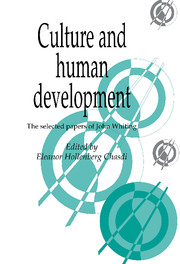Book contents
- Frontmatter
- Contents
- List of figures
- Preface
- Acknowledgments
- Introduction: John Whiting and anthropology
- Fifty years as a behavioral scientist: autobiographical notes
- Part I Theory and methods
- Introduction
- 1 Contributions of anthropology to the methods of studying child rearing
- 2 The cross-cultural method
- 3 A model for psychocultural research
- Part II Environment and history
- Part III Moral development
- Part IV Gender development
- Part V Development of social behavior
- Bibliography
- Complete bibliography of John W. M. Whiting's work
- Index
2 - The cross-cultural method
Published online by Cambridge University Press: 23 December 2009
- Frontmatter
- Contents
- List of figures
- Preface
- Acknowledgments
- Introduction: John Whiting and anthropology
- Fifty years as a behavioral scientist: autobiographical notes
- Part I Theory and methods
- Introduction
- 1 Contributions of anthropology to the methods of studying child rearing
- 2 The cross-cultural method
- 3 A model for psychocultural research
- Part II Environment and history
- Part III Moral development
- Part IV Gender development
- Part V Development of social behavior
- Bibliography
- Complete bibliography of John W. M. Whiting's work
- Index
Summary
The cross-cultural method utilizes data collected by anthropologists concerning the culture of various peoples throughout the world to test hypotheses concerning human behavior. Some of the hypotheses tested have been derived from theories of cultural evolution, others from theories concerned with the integration of culture, and still others, particularly in recent years, from theories of individual and social psychology.
The cross-cultural method was first used by E. B. Tylor (1889), who presented at the meetings of the Royal Anthropological Institute of Great Britain a paper entitled “On a method of investigating the development of institutions; applied to laws of marriage and descent.” It is interesting that Sir Francis Galton, one of the fathers of modern statistics, presided at this meeting. Although the intent of the study was to support Tylor's particular view of cultural evolution, its importance was that in the paper and the discussion which followed most of the basic assumptions of cross-cultural research were touched upon.
It was not until twenty-five years later, however, that the method was again used and, as before, to test evolutionary theory. Hobhouse, Wheeler, and Ginsberg (1915) published a monograph in which the frequency of occurrence of certain social institutions was determined for each stage of economic development from lower hunters to advanced agriculturalists. Essentially similar (but more methodologically and theoretically sophisticated) studies followed after another lapse of nearly twenty-five years with Simmons (1937) and Murdock (1937).
In the last fifteen years, the cross-cultural method has not only become more popular but has changed in its theoretical orientation. It has drawn upon the theory of general behavior science rather than that of cultural evolution.
- Type
- Chapter
- Information
- Culture and Human DevelopmentThe Selected Papers of John Whiting, pp. 76 - 88Publisher: Cambridge University PressPrint publication year: 1993

